Characteristics of species
Depending on the species, the plant can look like a huge tree (height 25-30 m), a bush or a liana. The shades of the inflorescences, the shape and color of the foliage are also different. Located at a close distance from each other, different types of metrosideros easily interbreed with each other. A natural hybrid arises. That is why artificial breeding of new varieties is practically not practiced: nature does everything by itself.
Felt
The native land of the species is New Zealand. Felt metrosideros is a sacred tree for the island's aborigines and is the centerpiece of many religious practices. The trunk branches out from the base and turns into a spreading spherical crown, covered with oval 8-centimeter leaves. The underside of the leaf plate is covered with a light white fluff. This species blooms in December.
The inflorescence shades range from red to deep pink.
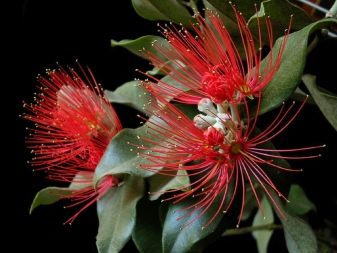

Carmine
The carmine shade of the inflorescences gave the name to the species. It is a liana-like shrub that blooms almost all year round. It is suitable for growing at home (dwarf hybrid). By cutting off the shoots, the plant can easily be given the desired shape. Rounded leaves have a slightly blunt tip. A dwarf hybrid grown in apartments is called "Carousel". Blooms from late winter to early spring. Inflorescences have a reddish tint.
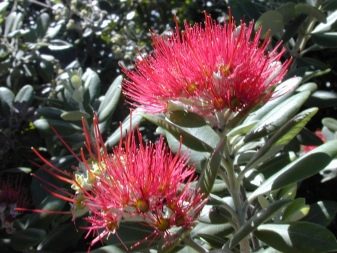
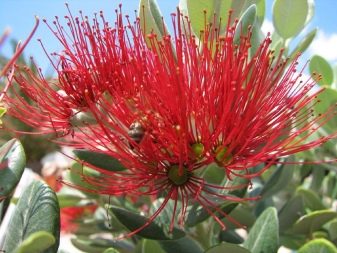
Kermadec
This species is a tree. Its height in the wild reaches 15 m. The evergreen plant is covered with bright red flowers all year round. A variegated variety (Variegata) is grown at home, the special charm of which is given by a yellowish border, framing the central green part of the leaves.
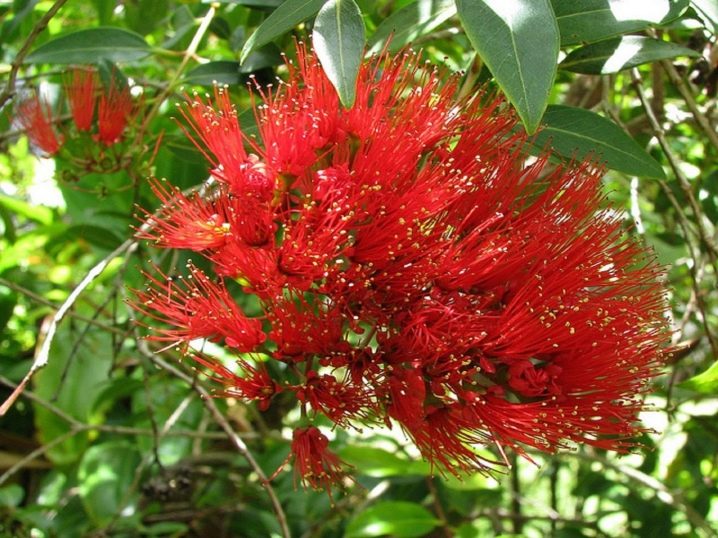
Kholmovoy
The height of the species does not exceed 4 meters, so it looks like a bush or a small tree with a very branched crown covered with rounded leaves. The color of the inflorescences is orange, yellow, salmon. For growing in indoor conditions, the variety "Thomas" is suitable. The height of such a bush is 1 m.
Volatile
The homeland is the Hawaiian Islands, where the indigenous people considered metrosideros sacred, belonging to the deity of volcanoes and fire. Growing conditions are key in shaping the appearance of a plant. It can be a tree, liana, or shrub. The color range of inflorescences is very diverse: yellow, pink, red, salmon, orange. An excellent honey plant attracts with insect aroma. The dense oval leaves are pointed towards the ends.
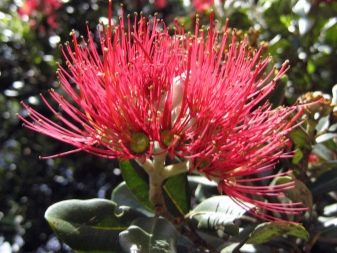
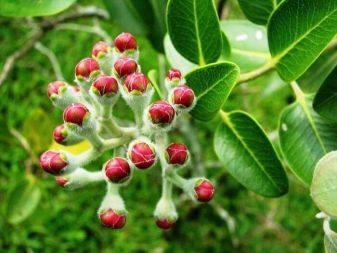
Glittering
Grows in the form of a vine. Its height in indoor conditions reaches 1.5 m, in the wild - 3-4 m. Flowering period: August - December. The dense, elongated leaves are emerald green in color.
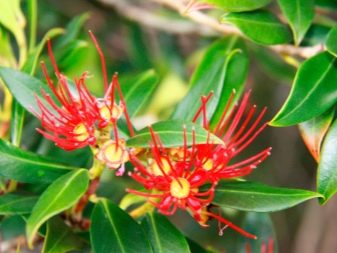
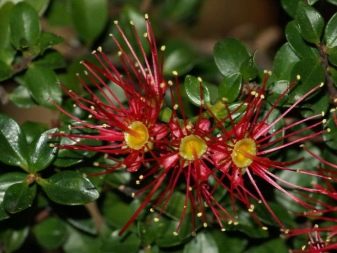
Perforated (Perforata)
It is a liana-like shrub, the height of the shoots of which can reach 4 m. The shoots are densely branched, over time covered with fibrous red-brown bark. The length of small rounded leaves does not exceed 1 cm. Their underside is covered with spots. In the middle of summer, the ends of the shoots are covered with large umbrellas of white inflorescences. After the plant fades, 5 small seeds are formed in the box.
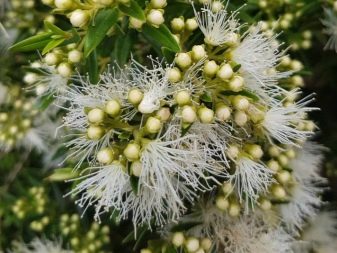
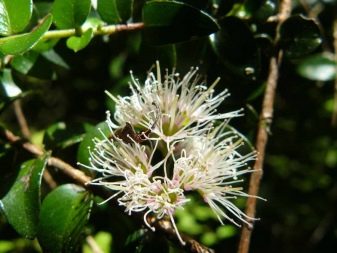
Powerful
Grows in the form of a tall tree with a spreading crown. A characteristic feature is the presence of spots on young leaves. The inflorescences are bright scarlet.

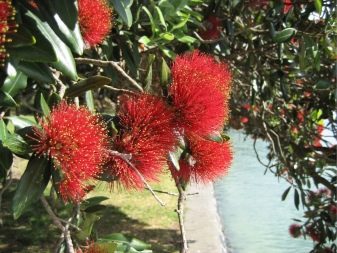
Kerria features

Kerria is a deciduous shrub, reaching a height of about 3 meters, it is distinguished by its rapid growth. The crown has a conical shape. Rod-shaped straight stems are colored green. The leaf plates of this shrub are similar to raspberry foliage. In length, they reach 10 centimeters, have a lanceolate shape, double toothed, pointed to the tops.The front surface of the foliage is bare, and the seamy side is pubescent. In the summer, it is painted in a pale green color, which changes to a rich yellow in autumn. Fragrant single flowers can be simple or double, they reach about 45 mm in diameter. The plant blooms from May to August, while the flowering duration is 3.5 weeks. Repeated flowering is often observed in autumn. The fruit is a juicy drupe of a brown-black color, however, when grown in middle latitudes, it does not form fruit.
Strong gusts of wind can easily injure the fragile stems of kerria, so it is recommended to plant it surrounded by the following flowering shrubs: bubblegum, spiraea, or Chinese tea. In spring, such a shrub will serve as a chic background for the blue phlox spread out, blue aquilegia, purple dwarf irises. Buzulnik is often grown in the neighborhood of kerriya, in harmony with this shrub during re-flowering in the fall.
Keria Japanese
Types of Haworthia with photos and names
Haworthia striped
Such a perennial plant has no trunk. The bush includes several basal dense rosettes, consisting of original thick lanceolate leaf plates, on the seamy surface they have convex stripes of white color, while the front side is smooth and green. The length of the leaf plates reaches 50 mm, and their width is 10-15 mm.
Haworthia drawn
This species is similar to striped haworthia, but this plant is less effective. On its leaf plates there are convex dots of green or white color. The lanceolate leaf plates are directed upward, their length is about 70 mm, and their width is up to 15 mm.
Haworthia meandering
This species is also called sinuous aloe. Haworthia has a not very high stem, which reaches a height of about 15 centimeters. The length of the dark green leaf plates is about 25 mm, their lower surface is convex and there are small warts on it.
Haworthia sticky
The height of the bush varies from 10 to 20 centimeters. Oval small leaf plates are arranged in 3 rows, they are erect and have a bent tip, their length is 25 mm and their width is 15 mm.
Haworthia navicular
Scaphoid glossy fleshy leaf plates have a window on the surface, they are part of the basal rosette, which reaches 10 centimeters in diameter, and in the case when there are side shoots, the diameter will be 15–20 centimeters.
Haworthia pearl
It is a herbaceous perennial succulent with virtually no stem. The basal rosette is formed from rigid leaf plates of a pointed-oval shape, their length is 70–80 mm, and their width is up to 25 mm. The green leaf blades on both surfaces have round bulges of pearl white color, they are similar to pearls and make the bush very effective.
Haworthia chess
Triangular thick sheet plates have a serrated edge, they are part of small rosettes. On the front surface of the foliage there are streaks of white color, which form a mesh, while on the seamy side there are warts.
Haworthia Reinwardt
The elongated rosette is formed from fleshy leaf plates of a triangular shape, their width is 10-15 mm, and their length is 35 mm. The seamy surface of the foliage is covered with rows of white protuberances located longitudinally and transversely, while they clearly stand out against the background of a dark-colored plate. This species has a kind of "zebrin": its warts are brighter, while the foliage is larger, and the bush looks extremely impressive. A young bush has an erect stem, but after a while it bends and lies down.
Haworthia retuza, or blunt
Hard fleshy triangular leaf plates are bent in the upper part, they reach 50 mm in length, on their surface there are transparent windows and streaks of light color. Foliage color can range from greenish brown or greenish red to green.There are low-chlorophyll and variegated forms. The "Gigant" variety has very large leaf plates, while the upper part of them is dissected by veins.
Such a culture can get sick only when agrotechnical rules are violated. If you follow the rules for growing such a crop, then the plant will never get sick.
JAVORTIA is a succulent plant. Types, care and breeding at home
1. Seven Secrets of Success:
| 1. Growing temperature: in spring and summer, the temperature regime ranges from 20 to 22 ° C. In the winter months - a cool dormant period at a temperature of 16 - 18 ° C. |
| 2. Lighting: light shading from direct sunlight in the daytime in the summer months, the rest of the time the plant will gladly bathe in the sun. Green-leaved varieties develop well in partial shade. |
| 3. Watering and Humidity: Water abundantly in spring and summer, but dry the surface of the substrate a few centimeters deep between waterings. In autumn and winter, the frequency of watering is reduced in accordance with the temperature in the room. It is better to increase air humidity with the onset of warm weather. |
| 4. Pruning: To maintain a compact shape, long stems are shortened in spring with a sharp, sterile instrument. |
| 5. Soil: tolerates a wide range of soil conditions, the soil must be well drained, organically rich substrates are preferred. |
| 6. Top dressing: in spring and summer, the hypocyrt is regularly fed with complex mineral or organic fertilizers 2 times a month. No feeding is carried out in autumn and winter. |
| 7. Reproduction: hypocyrta multiplies by rooting stem and apical cuttings in spring and summer, sowing seeds in spring. |
Botanical name: Hypocyrta, Nemantanthus.
Family
Origin. Brazil.
Description. The genus Hypocyrtus or nematanthus includes about 30 species of evergreen, usually epiphytic small shrubs, often with a woody stem. Hypocyrta is the old name of the genus nematanthus. Nematanthus has a characteristic flower with fused petals in the form of a sac, usually, but not always with a very small hole between them.
The flowers are axillary, slightly fragrant, about 2 cm in diameter, can be speckled white, pink, orange and red, and look like tiny goldfish. Leaves are dark or bright green, up to 4 cm long, opposite on long stems.
Height. The drooping branches of the hypocyrt can grow up to 50 cm long.
How to plant in open ground
How to prepare the ground
Buttercup (garden ranunculus) can grow and thrive quite well in a sunny location, but shade works best for it. The fact is that there such a flower retains a more saturated color of inflorescences, while the duration of flowering increases markedly. Also, the buttercup should be protected from the influence of drafts. Such a plant does not tolerate subzero temperatures; therefore, it should be planted only after the threat of frost has passed.
The soil for ranunculus is most suitable for light, neutral acidity and rich in nutrients. So, it can be peat or humus mixed with black soil. But it is imperative to add chalk to it to neutralize. On a site with loam, such a flower cannot be planted. Remember that the soil should perfectly absorb water during irrigation, but it should not linger in it for a long time. In order to avoid the formation of rot, plants need good drainage. To do this, add, for example, a small amount of sand to the bottom of the planting pit. Before planting a buttercup, you need to dig up the soil, while adding compost to it. And also to cultivate the soil with a foundation.
What time is the sowing of seeds
Growing buttercup from seeds is a rather difficult process, and all because they have a relatively low percentage of germination.Experienced gardeners are advised to collect seeds only from those flowers that have faded first. In order for the seeds not to spill out onto the surface of the soil, the inflorescences must be wrapped with gauze. Sowing should be done in mid-February. For this, a light substrate enriched with useful substances is used. After the seeds are sown, sprinkle them with a very thick (1.5 to 2 centimeters) layer of soil. On top of the container, you need to lay transparent glass or stretch the film. The container should be moved to a place with good lighting, where the temperature is within 15-17 degrees. If necessary, it is necessary to moisten the soil. The first seedlings should appear 14–20 days after sowing. When this happens, the cover should be removed from the container. When 2 pairs of true leaves grow, the ranunculus will need to be dived into individual pots. When the threat of frost has passed in the spring, these flowers should be transplanted into the garden. Flowering will be observed only next year, so if you want to get a quick result, this method of reproduction of ranunculus is not suitable for you.
What time is the planting of tubers
After the soil warms up and the frosts are left behind, you will need to plant buttercup tubers in open ground. As a rule, this time falls on the last days of April, the first - in May. Planting tubers is not difficult, but there are rules and tricks that should not be forgotten. Before planting tubers, they must be prepared. To do this, they are laid out in well-moistened moss, sawdust or on a moistened sponge. The tubers should sit for several hours. The same effect can be achieved by soaking in cold water or in a weak solution of potassium manganese. In some cases, it is recommended to add a growth-promoting substance to the liquid. Choose the most suitable place for such a flower at once, since it is not recommended to transplant it.
It is necessary to lower the tuber into the prepared planting hole with the "beak" down to a depth of 5 to 8 centimeters. It is necessary to maintain a distance of 10 to 15 centimeters between plants. In the event that frosts are expected, then the plantings should be covered with straw or special covering material. After 2-3 months, several peduncles will grow on each bush, and flowering will begin after some time.
Ranunculus planting and growing
Types of ariocarpus with photos and names
Ariocarpus agavoides (Ariocarpus agavoides)
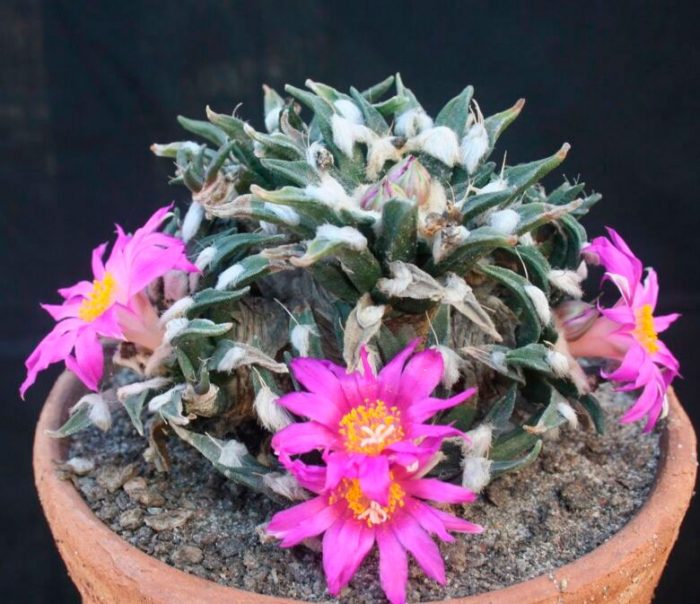
The rounded stem has a spherical shape. It is covered with non-ribbed smooth skin. The papillae of this species are flattened and thick. If you look at the bush from above, then its shape will be more like a star. The large flowers are dark pink.
Blunted ariocarpus (Ariocarpus retusus)
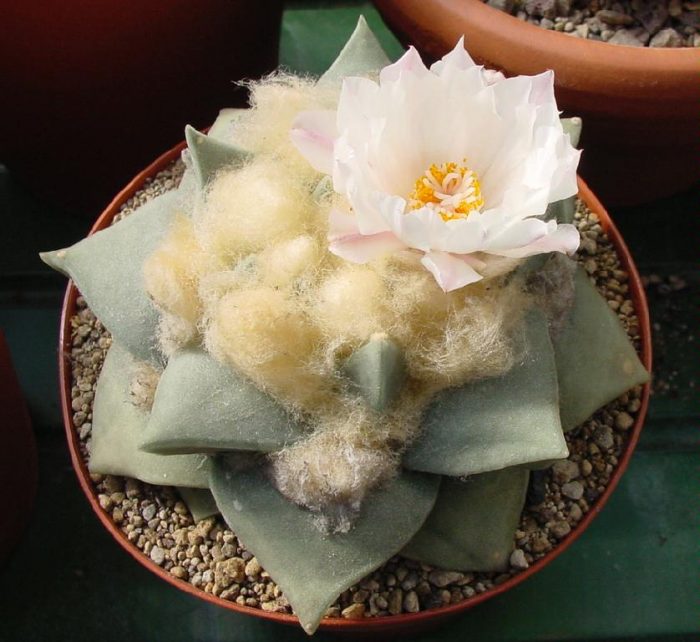
The stem of this plant is slightly larger when compared to the previous species. The upper part of the stem is covered with brown or white felt hairs. The papillae are pyramidal. During flowering, the bush is decorated with pink flowers.
Cracked ariocarpus (Ariocarpus fissuratus)

The stem of this species is very dense and looks more like a stone, which consists of lime. The shoot protrudes quite a bit from the soil, since it is deeply embedded in it. The surface of the part of the stem that protrudes above the ground is covered with hairs, making the bush more attractive. This plant can be easily distinguished from a stone when a large flower of pink or purple color opens on it.
Ariocarpus scaly (Ariocarpus furfuraceus)
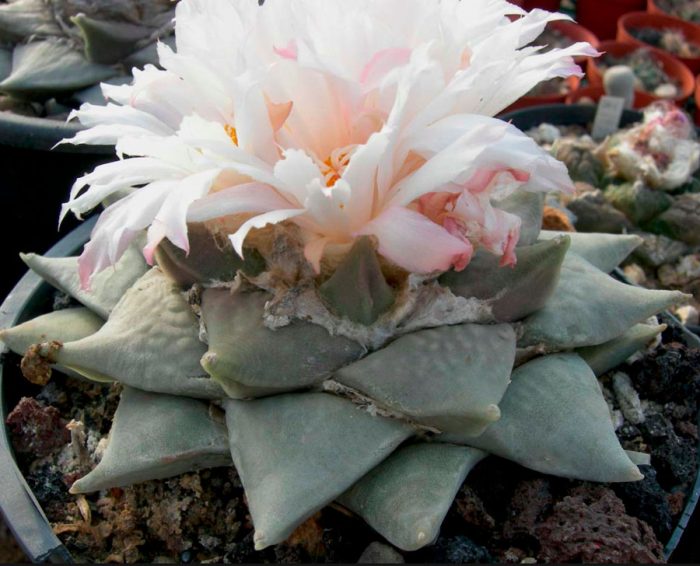
This species is noticeably larger than the others. Its stem can reach 10 to 13 centimeters in height, and up to 20 centimeters across, and even a little more. The papillae are triangular. The surface of the shoot is rough, which is reflected in the name of the species. Bell-shaped flowers can be cream or white.
Ariocarpus kotschoubeyanus, or kotzebue

The decorative effect of this species is that there are stripes on its stem. A lilac flower opens on a star-shaped stem during flowering.
Ariocarpus bravo (Ariocarpus bravoanus)
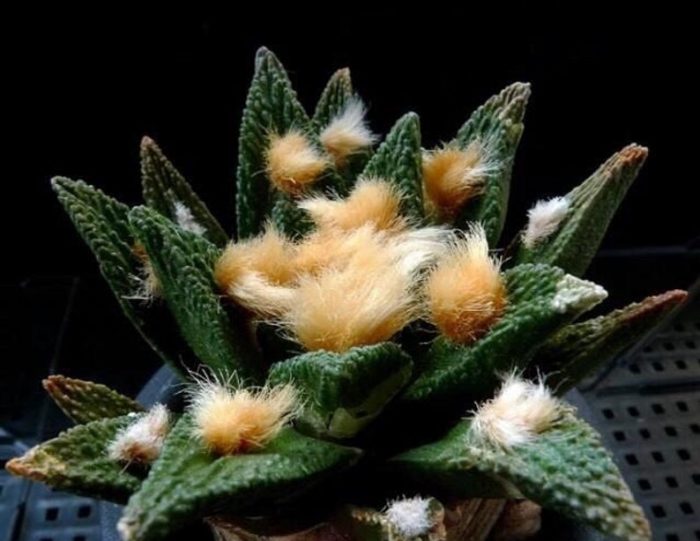
The low stem of this species is slow growing. Not very large flat papillae are painted in a dark shade. There is a whitish felt on the surface of the upper part of the stem. On the edges of the papillae there are woolly areoles. Not very large flowers are painted in bright pink.
Ariocarpus lloydii
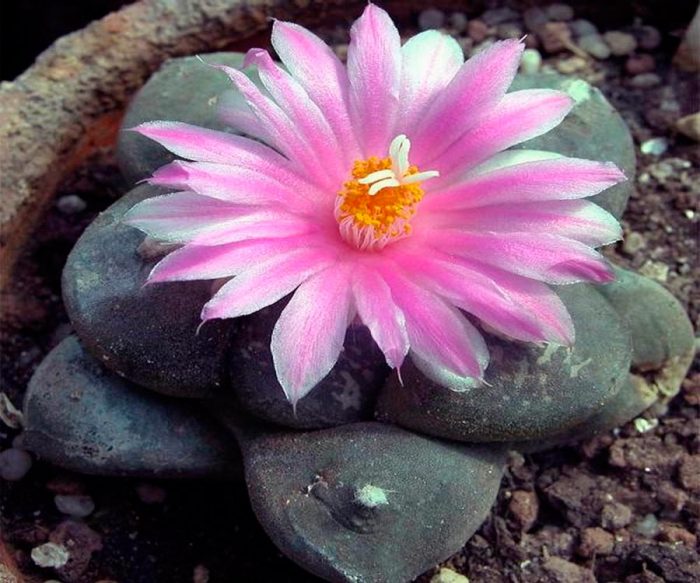
In this species, the shoot is also rounded and flat, and outwardly it is also very similar to a stone. Flowers can be purple or pink.
Ariocarpus triangular (Ariocarpus trigonus)

The species got its name thanks to the pointed triangular papillae. In diameter, the pale yellow flowers can reach about 50 mm.
Keel-shaped ariocarpus (Ariocarpus scapharostrus)

It also has a flattened green stem. There are very few keeled papillae on its surface. In the sinuses there is a pile of white, and the flowers are painted in a purple-pink hue.
Ariocarpus blunt - a cactus from the genus Ariocarpus (Ariocarpus retusus)
Types of metrosideros with a photo
Metrosideros carminea

It belongs to the subgenus Mearnsia, and is a native of New Zealand. This vine is evergreen and reaches 15 meters in length. It has thin aerial roots. Young stems are covered with a thin red-brown bark, which becomes darker with age. Small glossy leaves are colored dark green. They are oval in shape and taper slightly towards the end. Carmine flowers (crimson).
Metrosideros collina
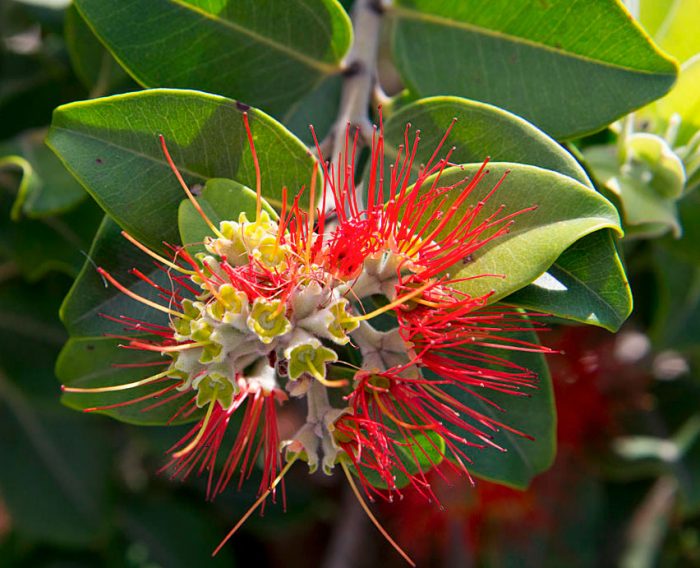
Belongs to the subgenus Metrosideros. Under natural conditions, this plant can be found on the islands of the Pacific Ocean from French Polynesia to Vanuatu. This is a rather tall (about 7 meters) shrub or a relatively small tree. Oval leaves are pointed at the ends. Their front side is painted in a dark green and has a grayish tint, and the back side is like felt. The flowers are colored deep red.
In this form, there are 2 varieties that are most popular:
- "Tahiti" is a dwarf tree that reaches a height of no more than 100 centimeters;
- "Tahitian sunset" is a mutation of the previous variety, and its foliage has a variegated color.
Spreading metrosideros (Metrosideros diffusa)
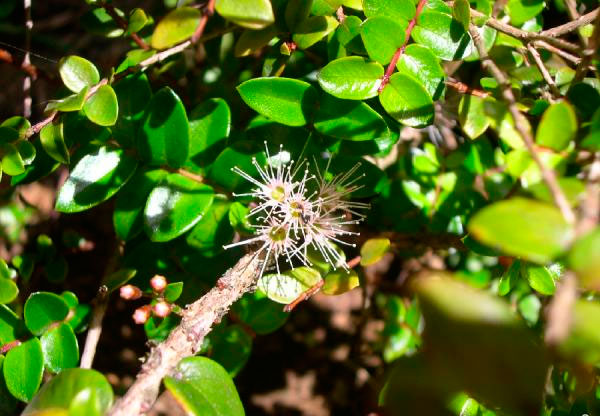
Belongs to the subgenus Mearnsia. Homeland is New Zealand. This vine with long shoots (up to 6 meters). Small leaves are only 2 centimeters long. The leaves have an oval-elongated shape, more like ovoid. The glossy front side is painted in deep green, and the back side is matte. The flowers are light pink or white.
Felt metrosideros (Metrosideros excelsa)
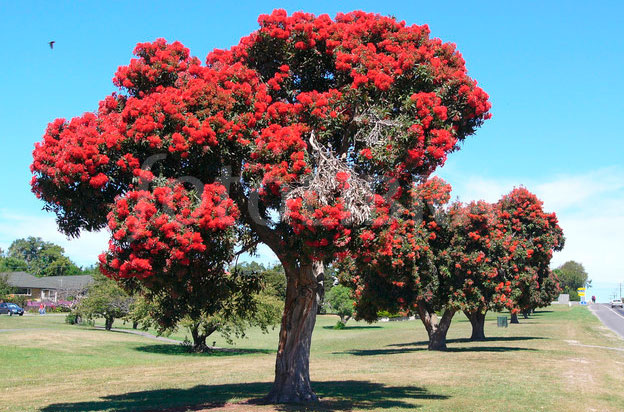
Or, as it is also called, pohutukawa - refers to the Metrosideros subgenus. Homeland is New Zealand. It is a tall (up to 25 meters in height) and strongly branched tree. On the branches and trunk of this plant, you can often see aerial, very long roots. Leathery leaves have an oval-elongated shape. In length they reach from 5 to 10 centimeters, and in width - from 2 to 5 centimeters. The seamy side of the leaves is covered with a layer of whitish hairs, which strongly resembles felt. The same layer of hairs is also present on the buds. Flowers are dark red-orange in color. There are varieties with pink or yellow flowers.
Metrosideros brilliant (Metrosideros fulgens)
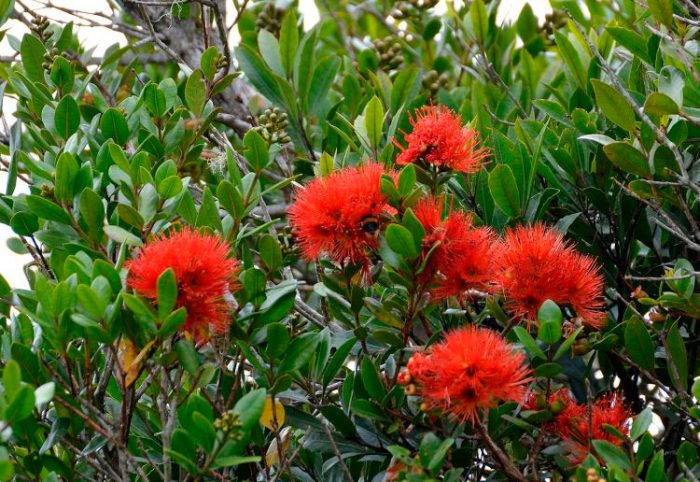
Belongs to the subgenus Mearnsia. This plant comes from New Zealand. This ligneous vine is branching and very powerful. In length, it can reach about 10 meters, and the trunk is 10 centimeters in diameter. Leathery, smooth green leaves are oval in shape. The flowers are dark red.
Metrosideros operculata

Belongs to the subgenus Mearnsia. Originally from New Caledonia. It is a relatively small shrub that can reach a height of 3 meters. The stems have a square-shaped cross-section, and silky hairs are located on their surface. The leaves have an elliptical-linear shape. They reach 4 centimeters in length and 1 centimeter in width. Often there are specimens with white flowers, but there are also red or pink ones.
Metrosideros sclerocarpa
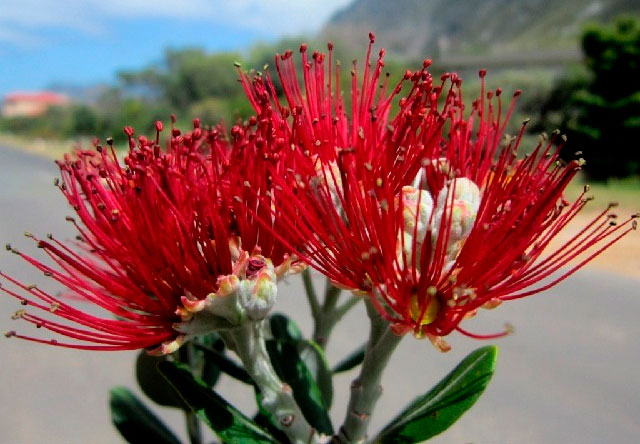
Belongs to the subgenus Metrosideros. His homeland is Australia. This is a relatively compact tree, which can reach a height of 10 meters. Leathery, green leaves are elliptical or ovoid. In length, they can reach from 3 to 6.5 centimeters, and in width - about 3 centimeters. The flowers are colored deep red.
Umbrella metrosideros (Metrosideros umbellata)
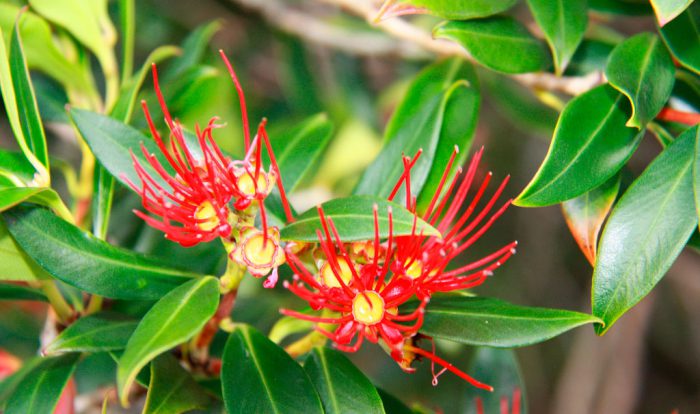
Belongs to the subgenus Metrosideros. Homeland is New Zealand. This small tree reaches a height of about 10 meters. Green-grayish leaves have a pointed-oval shape. In length, they can reach from 3 to 6 centimeters.
This species is the most undemanding of all to care for. It is very popular with gardeners and has a large number of varieties and hybrids.
Metrosideros polymorpha
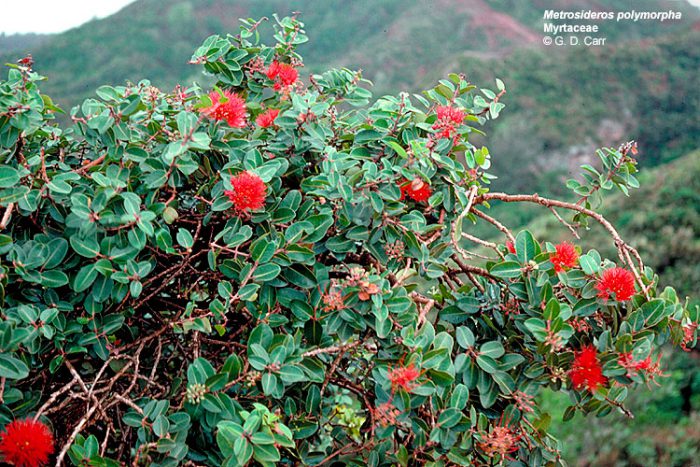
Belongs to the subgenus Metrosideros. The homeland is the Hawaiian Islands. Most often, this plant is a highly branching and rather tall shrub, but it also occurs in the form of a tree. The leaves are dark green-grayish to green in color. Their shape is obovate. In length they reach from 1 to 8 centimeters, and in width - from 1 to 5.5 centimeters. Most often, specimens with red flowers are found, but their color is also pink, red-orange or salmon.
Features of the sitnik (junkus)
Among the plants grown indoors, there are a large number of flowers that are used in landscape design. However, most of them are annuals or abundantly flowering shrubs. There are relatively few decorative deciduous crops among them. And there are even fewer exotic and very original plants among them. Sitnik refers to just such colors. In nature, it grows in reservoirs, and in the garden it is decorated with wet garden beds or various water bodies. This plant is rarely grown indoors.
However, due to its unique appearance, it attracts the attention of a large number of designers as well as florists. This plant has such an unusual appearance that it overshadows even the spectacular sansevieria.
Sitnik is also called Juncus or Juncus. It is directly related to the Juncaceae family. Sitnik is translated from Latin - "weave". The fact is that since ancient times, the stems of such a plant have been widely used for weaving shoes, baskets, and also mats. This perennial is a short-rhizome cereal. It is not frost-resistant, but it loves moisture very much. When grown at home, these plants reach a height of no more than 40-50 centimeters. Brownish scale-like sheaths are worn on the basis of tough thin shoots. Like other cereals, this plant also blooms. The inflorescences bear small flowers that look very unusual and spectacular. They are painted in off-white or light brown color and are part of panicle inflorescences, which have crowded branches that stand out for their asymmetry. The inflorescences lean slightly to the side of the bract, which looks like a continuation of the shoot.
At home, only 1 species of this plant is grown.
However, such a flower has a unique, but rather incredible appearance, and no doubt attracts special attention. At home, they grow only a species called the branchy rush (Juncus effusus)
And as a rule, only 1 variety of this type of rush is grown.It is such a plant that has spectacular twisted stems, on which there is not a single leaf.
Broad-leaved rush (Juncus effusus)
The spreading rush "Spiralis" (Juncus effusus "Spiralis") is most often called simply the spiral rush. By the way, it is often put up for sale in the store under that name. It belongs to cereal grasses. The rump is capable of producing a fairly spreading and dense turf, consisting of long thin leafless shoots. The stems of such a flower have a very unusual shape. So, they are twisted in a spiral so bizarrely that it may seem as if they were specially wound by hand.
However, in indoor conditions, not only the species with spiral stems is grown. So, they are also growing the "Blonde Ambition" variety. It differs from the previous variety in that the stems have a golden straw color, and their turns are large. There are also upright varieties in indoor conditions, which also look quite unusual and spectacular. For example:
- Rug "Aureostriata" - this variety has strong shoots with a variegated color. So, along their entire length, there are areas of green, as well as yellow.
- The “Pencil Grass” (Pencil Grass) - has straight and rather thick stems, which create a sod more like a large grass or a bundle of green brushwood. Hollow, shiny leaves are dark green in color and grow in a fairly dense turf. Their height can exceed 50 centimeters.
- Sitnik "Golden Line" - the stems of this variety have a golden color. At first glance, this plant may seem artificial, hollow, thin and almost perfectly straight shoots look so unusual.
Such plants can be used to decorate rooms with an extravagant and daring interior design. Sitnik can be an excellent substitute for sculpture or some rather voluminous decor element. They can be grown both in living rooms and in bathrooms and in greenhouses. This plant can be used as a horizontal space divider when dividing it into zones. Unique and very sophisticated curves and lines can visually expand the room.
Features of planting and care
Once you have purchased a rose, the first thing to do is to transplant it into a pot from a temporary container. But before that, give her a few days to adapt and get used to the new place.
Place the plant in a place where there is diffused lighting. First, remove all dry and damaged branches and wilted inflorescences. Treat the crown of the bush with Previkur.
If the rose is blooming, then the transplant procedure will have to be postponed until the end of this period. But now, finally, it's time to transplant the plant. Where do you start?
Transplant technology
In advance, purchase a pot or flowerpot one size larger than the one in which the bush was at the time of purchase. Wash and dry the pot
It is important that there are holes in it. Stagnation of moisture in the roots should not be allowed.
Be sure to fill the bottom with a drainage layer in the form of expanded clay or small stones. Ventilation and oxygen supply to the root system is essential for the development of a patio indoor rose.
It is imperative to purchase a special substrate for roses in a flower shop.
The soil should be nutritious, loose and light, moisture and air permeable.
If you still decide to transplant the bush after the purchase, then this must be done by transferring it from one pot to another, without touching the old soil and without disturbing the root system.
Moisten the soil, and then carefully observe the adaptation of the plant for a while after planting.
Ventilation and oxygen supply to the root system is essential for the development of a patio indoor rose.
It is imperative to purchase a special rose substrate at a flower shop.The soil should be nutritious, loose and light, moisture and air permeable.
If you still decide to transplant the bush after the purchase, then this must be done by transferring it from one pot to another, without touching the old soil and without disturbing the root system.
Moisten the soil, and then carefully observe the adaptation of the plant for a while after planting.
Temperature and humidity
The humidity in the room needs good, and the temperature is average. When it is dry and stuffy, the soil dries out quickly, and the shrub does not receive the required amount of nutrients.
To avoid overheating the soil and drying out the leaves, wrap the pot with white paper. When the air is very dry, harmful insects can attack the roses.
Spray the canopy regularly with a spray bottle and moisten the soil. In the summer, you can put the pot on the balcony, loggia, or take it out into the garden in partial shade.
If the room is dry due to heating devices, then spray not only the plants, but also the air around them.
Place in the apartment and lighting
- Absolutely all roses, regardless of variety and type, love the sun. Therefore, the best indoor location would be on the south, southeast or southwest side.
- When the sun is shining strongly and it is hot, then cover the window or move the flower for a while so that the leaves do not burn.
- Do not forget that there must be enough air in the room.
Fertilizers and watering
Use only settled water at room temperature to irrigate the bush and moisten the soil. Cold tap water will cause flower disease.
When the period of bud formation begins (in spring), then watering is carried out in a small moderate amount. During budding, flowering and active growth of the shrub, water often, but little by little, so that there is no stagnation of moisture in the roots.
Feed every 14 days with a special fertilizer for indoor flowering plants. Nitrogen-containing fertilizers are required for the growth of green mass, and before and after the flowering period, potassium-phosphorus fertilizers for the development of inflorescences and abundant flowering.
Dormant period
In the autumn months, the patio rose needs to be switched to a different maintenance mode:
- Fertilizers and fertilizing are not recommended.
- The number of waterings is reduced.
- The buds and unopened flowers must be removed and the temperature in the room reduced.
When the leaves begin to acquire a yellowish tint, then the plant must be transferred to a room where the air temperature should be no more than +10 degrees. There the bush will shed its leaves. Watering is carried out periodically, only when the top layer of the earth dries well.


